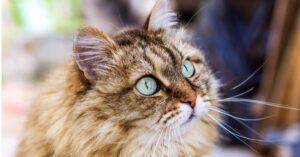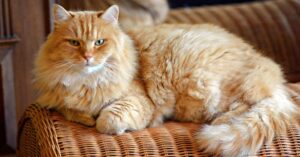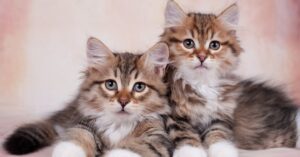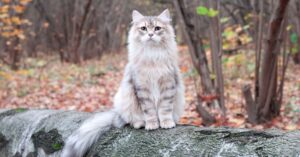The Siberian cat, also known as the Siberian Forest Cat, is an ancient breed that’s been around for centuries.
While it has long been beloved in its native Russia—featuring prominently in folklore and fairy tales—the Siberian didn’t make its way to the United States until 1990, after the fall of the Soviet Union. These affectionate, playful cats are among the most people-loving breeds you can find.

Breed History
The Siberian cat’s roots stretch back hundreds, if not thousands, of years. Although it’s firmly tied to Russia, it’s believed these cats may have descended from Asian cats brought to Siberia to help control rodent populations among early settlers. While records date their existence back at least to the 1600s, Siberians likely developed their famously thick coats as an adaptation to the harsh climate.
Known for their excellent rat-hunting skills, Siberians eventually spread throughout Russia. In fact, they’re considered the ancestors of all modern long-haired cat breeds, sharing many traits with cats like the Norwegian Forest Cat. The Siberian became the first recognized cat breed native to Russia in the late 1980s and earned international breed registration by 1992.

The first Siberians arrived in the U.S. during the early 1990s as breeding programs got underway, although they’re still relatively rare here due to high import costs. In Europe and Russia, however, Siberians are more common—and they’re even considered the national cat of Russia.
Traits: What to Know Before You Buy
Siberians are known for their easygoing, sociable personalities. They tend to get along well with everyone—people, dogs, and other cats alike.
Despite their laid-back nature, Siberians are also highly playful and energetic. Don’t be surprised if your cat brings you toys or balls to play fetch. Their athleticism is impressive, too; they love to climb anything that can support their weight (and sometimes things that can’t!).
Owning a Siberian does require some maintenance. Their luxurious coat needs regular grooming, and they benefit from daily dental care, weekly ear checks, and occasional nail trims.
One of the breed’s standout features is its beautiful, thick fur, which comes in almost every color imaginable: white, black, blue, red, silver, and many combinations in between.

Personality
Unlike many other cat breeds, the Siberian thrives on human attention. They’ll follow you from room to room and eagerly greet you at the door when you come home. However, their devotion can sometimes be a little disruptive—like when they insist on walking across your keyboard or interrupting your reading.
Still, their affectionate, fearless, and playful nature makes them ideal companions for households of all kinds, including families with young children or larger dogs. Not much rattles a Siberian, which only adds to their charm.
Size and Weight

Siberians are strong, muscular cats, usually measuring 17 to 25 inches in length. They have broad chests, sturdy legs, long tufted ears, and big, expressive eyes. On average, they weigh between 15 and 20 pounds, although some can reach up to 25 pounds.
Price
A Siberian kitten from a reputable breeder typically costs between $1,200 and $2,000. Show-quality kittens can cost even more, while adopting one from a shelter might be significantly cheaper. Keep in mind that there are additional costs for food, toys, vet care, and other essentials.
Kittens
Siberian kittens are usually ready to go to their new homes between 12 and 16 weeks old, once they’ve received their first vaccinations. Early socialization and training are key to raising a well-mannered adult cat, although you should be prepared for a lot of playful energy!
Most of their growth happens in the first 18 months, requiring high-quality kitten food to support their development. However, it can take up to five years for Siberians to reach their full adult size due to their slow muscle growth.

Lifespan
Siberian cats typically live between 11 and 15 years, but many reach 18 years with good care. While they’re generally healthy, Siberians can be prone to certain conditions like kidney disease, gum disease, cancer, and hypertrophic cardiomyopathy (a serious heart disease).
If you’re buying from a breeder, make sure they provide health certifications to minimize the risk of genetic conditions. Regular veterinary checkups are also crucial to keeping your Siberian healthy.
Purebred vs. Mixed
A purebred Siberian has a distinctive look: a wedge-shaped head, long tufted ears, thick tail, sturdy body, and large, tufted paws. Their big round eyes can be green, yellow, or blue. Siberians can be mixed with other breeds, including the Norwegian Forest Cat and Maine Coon, resulting in thick, fluffy coats and interesting fur patterns.
Types of Siberian Cats and Colors
Siberians boast a thick, triple-layered coat made to withstand brutal winters. It needs brushing a few times a week to stay clean and mat-free, and during shedding seasons (spring and fall), you might need to brush them daily.

While there aren’t distinct “types” of Siberian cats, their coats come in a stunning array of colors and patterns, all accepted by the Cat Fanciers’ Association:
-
All-white
-
Mackerel patterned
-
Colorpoint
-
Black
-
Blue
-
Silver
-
Cameo
-
Tortoiseshell
-
Smoke
-
Tabby patterned
An interesting piece of breed history is the Neva Masquerade—a colorpoint variety named after the Neva River in St. Petersburg. These cats have mask-like facial markings and always have striking blue eyes, though otherwise, they’re just like any other Siberian.
